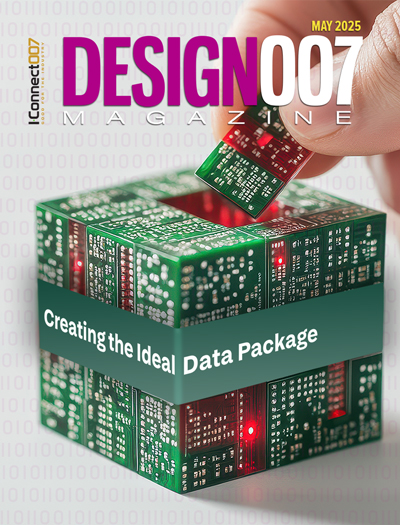-

- News
- Books
Featured Books
- design007 Magazine
Latest Issues
Current Issue
Creating the Ideal Data Package
Why is it so difficult to create the ideal data package? Many of these simple errors can be alleviated by paying attention to detail—and knowing what issues to look out for. So, this month, our experts weigh in on the best practices for creating the ideal design data package for your design.

Designing Through the Noise
Our experts discuss the constantly evolving world of RF design, including the many tradeoffs, material considerations, and design tips and techniques that designers and design engineers need to know to succeed in this high-frequency realm.

Learning to Speak ‘Fab’
Our expert contributors clear up many of the miscommunication problems between PCB designers and their fab and assembly stakeholders. As you will see, a little extra planning early in the design cycle can go a long way toward maintaining open lines of communication with the fab and assembly folks.
- Articles
- Columns
Search Console
- Links
- Media kit
||| MENU - design007 Magazine
Estimated reading time: 2 minutes
The Bare (Board) Truth: Eliminate Confusion
This column will address eliminating confusion that creates remakes both from the end-user/designer and the fabrication house. First, let’s talk about being clear about your intentions. What are some of the things that create miscommunication, lost time, and sometimes even remakes at the fabrication house of your choice? The first thing is querying the fabrication house for impedance numbers.
Let’s say you’ve asked for a material type on your drawing that is not either readily available or used by your fabricator. Here, you should expect the fabrication house to respond quickly and have all the deviations at once for you to review. This includes any impedance width changes, material types, or copper weights to produce the part. Any deviations regarding drawing notes such as wrap plate requirements that cannot be incorporated due to insufficient space or the extra etch compensation to meet the wrap plate requirement should also be addressed.
If your chosen fabricator comes back and says the material you have called out is not a standard stocked material for them, you are asking for a three-day turn. Giving you an alternative is great, but if by changing to the material they suggest your trace widths or spaces change to the point the part has to be laid out again, this can be very frustrating for the board designer.
To mitigate this from happening, give yourself and addition mil or two of space. This will allow the fabricator to resize the traces to meet your impedance and adjust dielectrics. For example, if you have designed the part as a 0.1-mm trace and space, this does not allow the fabricator to resize the traces without affecting the spaces. It may even require the fabricator to ask for a lighter starting copper weight to allow for a 0.5-mil change in trace width to still make the part producible.
This is where the etch compensation based on starting copper weight is key to remember when designing the part to allow for slight changes to either dielectric distance, starting copper weight, or trace width changes to meet your impedances. Having gone through all this, if the fabrication house does not state additional deviations due to the color of solder mask, material finish type, or even the material UL rating required, this is also frustrating for the designer. You should communicate with an engineering person at the fabrication house ahead of time to preclude these deviations from slowing down the part.
To read this entire column, which appeared in the February 2019 issue of Design007 Magazine, click here.
For more clarity in the design process, be sure to read and refer to Mark Thompson's "The Perfect Data Package," a concise book available at I-007eBooks.
More Columns from The Bare (Board) Truth
The Bare (Board) Truth: My Top Six Design ChallengesThe Bare (Board) Truth: Via Basics
The Bare (Board) Truth: 5 Questions About Improving Thermal Management
The Bare (Board) Truth: Teaching the Next Generation—An Overview of Today’s University Courses
The Bare (Board) Truth: Fabrication Starts With Solid Design Practices
Board Negotiations: Design Rules and Tolerances
The Bare (Board) Truth: Getting on the Same Page—A Data Story
The Bare (Board) Truth: Refining Output Data Packages for Fabricators


